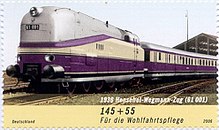Wegmann & Co.
| Wegmann & Co. | |
|---|---|
| legal form | Limited partnership |
| founding | 1882 (as Casseler Waggonfabriken von Wegmann, Harkort & Co. ) |
| resolution | 1999 |
| Reason for dissolution | Merger with the armaments activities of Krauss-Maffei to form Krauss-Maffei Wegmann |
| Seat | Kassel , Germany |
| management |
|
| Branch | Railway car manufacturer , defense industry , motor vehicle manufacturer |
Wegmann & Co. was a German car factory in 1882 in Kassel of Commerce Peter Wegmann with Richard Harkort as Casseler Waggonfabriken by Wegmann, Harkort & Co. was founded. In 1886 the company was named Wegmann & Co. In 1999, the armaments activities of Krauss-Maffei , a subsidiary of Mannesmann at the time , merged to form Krauss-Maffei Wegmann (KMW).
history
In 1912 the company was taken over by the engineer August Bode and the businessman Conrad Köhler. Towards the end of the First World War in 1917, the company received the order to build the first German tank , the K-car . In the 1920s, the company's focus was initially again on building railroad cars .
In 1925 the 4/20 PS sports car was presented at the German Motor Show in Berlin. The vehicle was equipped with a streamlined wooden body that was covered with synthetic leather. It offered space for two to three people. The wheelbase was 260 cm. There are different details about the engine. One source mentions a four - cylinder boxer engine from the Steudel works with exactly 1016 cm³ displacement . A second source confirms the four-cylinder engine, but does not provide any information on the origin. Another source indicates that it was a proprietary four-cylinder, four- stroke , water-cooled engine . Werner Oswald and Ulrich Kubisch name a two-cylinder boxer engine that was mounted in the rear. A displacement of about 1000 cm³ and a power of 20 hp are confirmed . A three-speed gearbox and cardan drive are also mentioned. It is not known how many copies were produced. In addition, a small truck with 2/10 HP has been handed down. It had a two-cylinder two- stroke engine from DKW with either 412 cm³ displacement, 10 HP power and air cooling or 389 cm³ displacement, 14 HP power and water cooling. The transmission had two gears. The wheelbase was 165 cm. The curb weight was given as 400 kg and the payload as 750 to 1000 kg. At the time, the company had the legal form of a limited partnership .
The company became known in the 1930s as a manufacturer of passenger coaches for the Henschel-Wegmann train . Wegmann & Co supplied the six apron car prototypes in 1936 . Wegmann also built some of the saloon cars for the special Führer train that was available to Adolf Hitler, and the 10205 saloon car . During the time of the National Socialist dictatorship, the exploitation of forced laborers, prisoners of war and political prisoners was part of the corporate policy of August Bode, who later became the military leader . Armored vehicles were assembled and, above all, armored turrets were produced.
Even after the Second World War, Wegmann initially made wagons and trams again . In 1950, under the direction of Fritz Bode, a battery-powered bus was designed and presented at the 1951 IAA on a shortened Krauss-Maffei chassis of the type KMO 133. Six AFA batteries were carried in a single-axle trailer. In 1959, Wegmann built the Kar 6209 tunnel inspection vehicle for the German Federal Railroad in collaboration with Schaltbau and AFA .
In the early 1960s, the company took part in the development and production of the Leopard 1 and Leopard 2 main battle tanks . The light artillery rocket system (LARS) , which was used by the Bundeswehr from 1969 to 2000, was later added to the armaments industry . In 1960 the sons of August Bode, Engelhard and Fritz, took over the management. Eight years later the company was split up into two independent companies - Wegmann & Co. and the Bode & Co. brothers. In 1979 Wegmann & Co. was passed on to the sons of Fritz, Manfred and Wolfgang Bode.
In 1999 Wegmann & Co. was merged into the arms company Krauss-Maffei Wegmann (KMW), with 51% of the company shares being owned by Wegmann und Co. Unternehmens-Holding KG in Kassel, which is controlled by the Bode family. The street name of the Kassel company location of KMW still reminds of the former owner and honorary citizen of Kassel, the factory owner August Bode.
See also
- List of honorary citizens of Kassel
- BKK Herkules , founded in 1888 as Wegmann & Co.'s company health insurance fund
literature
- Thomas Vollmer, Ralf Kulla: tanks from Kassel. The armaments production of the companies Henschel and Wegmann. Prolog-Verlag, Kassel 1994, ISBN 3-88122-996-5 .
Individual evidence
- ^ A b c d Hans Christoph von Seherr-Thoss : The German automobile industry. Documentation from 1886 until today . Deutsche Verlags-Anstalt, Stuttgart 1974, ISBN 3-421-02284-4 , p. 128 .
- ↑ Harald H. Linz, Halwart Schrader : The International Automobile Encyclopedia . United Soft Media Verlag, Munich 2008, ISBN 978-3-8032-9876-8 , Wegmann chapter.
- ↑ George Nicholas Georgano (Ed.): The Beaulieu Encyclopedia of the Automobile . Volume 3: P-Z . Fitzroy Dearborn Publishers, Chicago 2001, ISBN 1-57958-293-1 , pp. 1729 (English).
- ↑ Werner Oswald : German Cars 1920–1945. 10th edition, Motorbuch-Verlag, Stuttgart 1996, ISBN 3-87943-519-7 , p. 462.
- ↑ Ulrich Kubisch : German car brands from A – Z. VF Verlagsgesellschaft, Mainz 1993, ISBN 3-926917-09-1 , p. 147.
- ↑ Alfred Gottwaldt: saloon car 10,205th of the rail into the museum . 4th edition, Bonn 2007, ISBN 978-3-937-08615-6 , p. 6.
- ↑ Holger Werner: Wegmann accumulator omnibus . In: Yearbook Omnibus 2017 , Podszun-Motorbücher Verlag, Brilon 2016, ISBN 978-3-86133-815-4 , pp. 37–42

